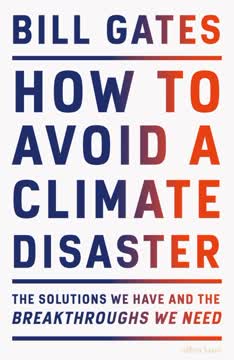Key Takeaways
1. COVID-19 exposed global health inequities and the need for pandemic preparedness
Things can be better and bad.
Global health disparities persist. Despite improvements in child mortality rates and overall health outcomes worldwide, significant inequities remain between rich and poor countries. COVID-19 highlighted these disparities, with low- and middle-income countries facing greater challenges in accessing vaccines, treatments, and essential medical supplies.
Pandemic preparedness is crucial. The world was largely unprepared for COVID-19, despite warnings from experts. To prevent future pandemics, we must invest in:
- Improved disease surveillance systems
- Rapid response capabilities
- Stronger health infrastructure in all countries
- Research and development of vaccines and treatments
- Global cooperation and funding mechanisms
2. Early detection and rapid response are crucial to prevent outbreaks from becoming pandemics
Outbreaks are inevitable, but pandemics are optional.
Disease surveillance is critical. Detecting outbreaks early requires robust surveillance systems that can:
- Monitor for unusual disease patterns
- Quickly identify new pathogens
- Track the spread of infections
- Share information globally
Rapid response capabilities are essential. Once an outbreak is detected, swift action is needed to contain it. This includes:
- Deploying trained personnel to affected areas
- Implementing testing and contact tracing
- Enacting appropriate containment measures
- Developing and distributing diagnostics, treatments, and vaccines
The proposed Global Epidemic Response and Mobilization (GERM) team would serve as a dedicated global resource for coordinating these efforts and ensuring a rapid, effective response to emerging threats.
3. Nonpharmaceutical interventions are vital tools in controlling disease spread
If it looks like you're overreacting, you're probably doing the right thing.
Early implementation is key. Nonpharmaceutical interventions (NPIs) such as masks, social distancing, and lockdowns can significantly reduce disease transmission when implemented early and consistently. While these measures can be disruptive, they are often the most effective tools available in the early stages of an outbreak.
Tailored approaches are necessary. The effectiveness of NPIs can vary depending on:
- Local conditions and cultural factors
- Population density and demographics
- Economic considerations
- Healthcare system capacity
Governments and public health officials must carefully balance the benefits of NPIs with their potential negative impacts, adapting strategies as new information becomes available.
4. Investing in vaccine and treatment development can save millions of lives
Innovation is my hammer, and I try to use it on every nail I see.
Accelerated development is possible. The rapid development of COVID-19 vaccines demonstrated that with sufficient resources and global cooperation, it is possible to create safe and effective vaccines in record time. Key factors include:
- Advances in vaccine technologies (e.g., mRNA platforms)
- Streamlined regulatory processes
- Parallel clinical trials and manufacturing scale-up
- Global collaboration among researchers, companies, and governments
Continued investment is crucial. To prepare for future pandemics, we must:
- Fund research into universal vaccines and broad-spectrum antivirals
- Develop new drug discovery techniques and manufacturing processes
- Improve vaccine distribution and delivery systems
- Address vaccine hesitancy and misinformation
5. Strengthening health systems globally is essential for pandemic prevention
If you're a flight attendant, your job has probably evolved a lot in recent years but not because of increased digitization.
Robust health systems are the foundation of preparedness. Strong primary healthcare and public health infrastructure are essential for:
- Early detection and response to outbreaks
- Effective implementation of containment measures
- Equitable distribution of vaccines and treatments
- Management of routine health needs during crises
Investing in global health pays dividends. Improving health systems in low- and middle-income countries not only saves lives but also:
- Reduces the risk of global disease spread
- Strengthens economic stability and growth
- Enhances global security and cooperation
Key areas for investment include:
- Training and retaining healthcare workers
- Improving supply chains for medical supplies
- Upgrading healthcare facilities and equipment
- Enhancing data collection and analysis capabilities
6. Practice and preparation through simulations are key to effective outbreak response
Don't think of this spending as charity or even traditional development assistance. Just like defense spending, it would be part of every nation's responsibility to ensure the safety and security of its citizens.
Regular simulations improve readiness. Conducting full-scale exercises that simulate pandemic scenarios can:
- Identify weaknesses in response systems
- Improve coordination among different agencies and sectors
- Test and refine emergency plans and protocols
- Familiarize personnel with their roles and responsibilities
Learning from past experiences is crucial. Analyzing the successes and failures of previous outbreaks and response efforts can inform future preparedness. This includes:
- Studying the effectiveness of various interventions
- Identifying best practices for communication and coordination
- Addressing gaps in supply chains and resource allocation
- Improving decision-making processes during crises
7. Global cooperation and funding are necessary to prevent future pandemics
The opposite of complacency isn't fear. It's action.
Pandemic prevention requires global commitment. No single country can prevent pandemics alone. International cooperation is essential for:
- Sharing data and resources
- Coordinating research and development efforts
- Ensuring equitable access to vaccines and treatments
- Implementing consistent public health measures across borders
Sustained funding is crucial. Preventing pandemics requires long-term investment in:
- Global health infrastructure
- Research and development of new tools and technologies
- Surveillance and early warning systems
- Emergency response capabilities
Governments, international organizations, and the private sector must work together to create sustainable funding mechanisms and ensure that pandemic preparedness remains a global priority, even in the absence of an immediate threat.
Last updated:
FAQ
What's How to Prevent the Next Pandemic about?
- Pandemic preparedness focus: The book emphasizes strategies to prevent future pandemics, learning from COVID-19. Gates advocates for a global response team and improved health systems for early outbreak detection and response.
- Learning from COVID-19: Gates reflects on past mistakes and outlines actionable steps for better preparedness. He believes the world can provide basic care to everyone and be ready for emerging diseases.
- Innovative solutions: The book proposes methods like improved diagnostics, vaccine development, and public health strategies to combat infectious diseases effectively.
Why should I read How to Prevent the Next Pandemic?
- Timely insights: The book offers crucial insights into preparing for future pandemics amidst ongoing global health challenges. Gates shares his extensive experience in global health and philanthropy.
- Actionable recommendations: It provides practical steps for governments, organizations, and individuals to improve pandemic preparedness, emphasizing investment in health systems and research.
- Informed perspective: Gates draws on his work with the Gates Foundation and collaborations with health experts, offering a well-rounded view of the issues.
What are the key takeaways of How to Prevent the Next Pandemic?
- Pandemic prevention team: Gates advocates for a global team to monitor and respond to outbreaks, responsible for early detection, data sharing, and coordinating responses.
- Invest in health systems: Strengthening health systems in low- and middle-income countries is crucial for effective pandemic response, enabling early outbreak detection and management.
- Rapid vaccine development: The book highlights the need for quick vaccine development and equitable distribution, aiming for global delivery within six months of identifying a new pathogen.
What are the best quotes from How to Prevent the Next Pandemic and what do they mean?
- “Outbreaks are inevitable, but pandemics are optional.” This quote emphasizes that while diseases will spread, effective systems and preparedness can prevent them from becoming global crises.
- “If it looks like you’re overreacting, you’re probably doing the right thing.” Gates stresses the importance of early and decisive action during an outbreak, suggesting that caution can save lives.
- “We need to invest in all the elements of a robust health system.” This statement highlights the need for comprehensive health infrastructure to manage diseases effectively, linking prevention and treatment.
What specific methods does Bill Gates suggest for preventing future pandemics in How to Prevent the Next Pandemic?
- GERM team establishment: Gates proposes creating a Global Epidemic Response and Mobilization team to monitor outbreaks, coordinate responses, and ensure countries are prepared for threats.
- Enhance disease surveillance: The book emphasizes improving disease detection and reporting mechanisms, investing in technology and training for quick outbreak identification.
- Develop universal vaccines: Gates advocates for research into vaccines that protect against multiple virus strains, ensuring better protection against future outbreaks.
How does How to Prevent the Next Pandemic address the issue of vaccine distribution?
- Equitable access: Gates stresses the importance of making vaccines available to everyone, especially in low-income countries, highlighting organizations like Gavi's role in facilitating access.
- Rapid manufacturing: The book outlines strategies for scaling up vaccine production quickly in response to threats, emphasizing coordinated global efforts for timely distribution.
- Vaccine hesitancy: Gates acknowledges challenges posed by misinformation and hesitancy, advocating for clear communication and education to build trust and encourage uptake.
What role does technology play in pandemic prevention according to How to Prevent the Next Pandemic?
- Innovative diagnostics: Gates discusses the importance of rapid and accurate diagnostic tests for early infection identification, highlighting technological advancements for widespread testing.
- Data sharing: The book emphasizes robust data systems for tracking outbreaks and sharing information globally, enhancing collaboration among health organizations and governments.
- Vaccine development technologies: Gates points to mRNA technology as a breakthrough for rapid vaccine development, advocating for continued investment in such technologies.
How does How to Prevent the Next Pandemic suggest improving global health systems?
- Strengthening infrastructure: Gates emphasizes investing in health systems in low- and middle-income countries, including training healthcare workers and ensuring access to medical supplies.
- Building trust: The book discusses fostering trust between communities and health authorities, suggesting transparent communication and community engagement for effective interventions.
- Regular drills: Gates advocates for regular simulations and drills to test health systems' readiness, identifying weaknesses and improving response strategies.
What are the challenges in detecting outbreaks early as discussed in How to Prevent the Next Pandemic?
- Underreporting: Gates highlights that many illnesses go unreported, especially in low-income countries with weak health systems, hindering early detection and response.
- Limited healthcare access: Barriers to healthcare can prevent individuals from seeking treatment and reporting symptoms, particularly in rural and underserved areas.
- Surveillance system improvement: Gates argues for investing in technology and training to enhance disease surveillance systems for early outbreak detection.
How does How to Prevent the Next Pandemic propose to address misinformation about health measures?
- Clear communication: Gates emphasizes the need for transparent and accurate information from health authorities to counter misinformation and build public trust.
- Community engagement: The book suggests involving local leaders in health messaging to reach diverse populations, using trusted figures to disseminate accurate information.
- Social media use: Gates discusses using social media responsibly to promote accurate health information and combat false claims.
What lessons from COVID-19 does How to Prevent the Next Pandemic highlight for future preparedness?
- Early action importance: Gates stresses that timely interventions can significantly reduce outbreak impact, learning from countries that acted quickly to inform future responses.
- Global collaboration need: The book highlights that pandemics require coordinated global responses, with collaboration among countries, organizations, and health experts crucial for effective management.
- Research investment: Gates argues for ongoing investment in health research and technology, developing new vaccines, treatments, and diagnostic tools for emerging diseases.
How does How to Prevent the Next Pandemic address vaccine inequity?
- Highlighting disparities: Gates discusses differences in vaccine access between wealthy and low-income countries, emphasizing the dire consequences for global health.
- Moral obligation: The book argues for equitable vaccine access as a moral imperative, stressing that health disparities affect everyone and require collective efforts to address.
- Improvement strategies: Gates outlines strategies like second-source agreements and tiered pricing to make vaccines more accessible to underserved populations.
Review Summary
How to Prevent the Next Pandemic received mixed reviews. Many praised Gates' clear writing style, practical approach, and evidence-based suggestions for improving global pandemic preparedness. Supporters appreciated his insights on vaccine development, testing, and health system strengthening. However, critics accused Gates of promoting medical tyranny and questioned his qualifications. Some reviewers found the book basic or obvious, while others considered it an essential read. The controversy surrounding Gates himself influenced many negative reviews, with some readers dismissing the book outright based on their views of the author.
Similar Books










Download PDF
Download EPUB
.epub digital book format is ideal for reading ebooks on phones, tablets, and e-readers.






